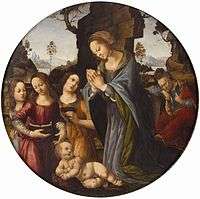Lorenzo di Credi

Lorenzo di Credi (c. 1459 – January 12, 1537) was an Italian Renaissance painter and sculptor. He first influenced Leonardo da Vinci and then was greatly influenced by him.
Life

Born in Florence, he started to work in Andrea del Verrocchio's workshop. After the death of his master, he inherited the direction of the workshop. For Pistoia Cathedral he completed the painting of the Madonna Enthroned between John the Baptist and St. Donatus which had been partially painted by his master, Verrocchio, but was left unfinished when Verrocchio went to Venice.
Amongst his other early works are an Annunciation in the Uffizi, a Madonna with Child in the Galleria Sabauda of Turin, and Adoration of the Child in the Querini Stampalia of Venice. Of a later period are a Madonna and Saints (Musée du Louvre) (1493) and an Adoration of the Child in the Uffizi. In Fiesole, he remade parts of Fra Angelico's panels on the altars of the church of San Domenico.
Lorenzo's mature works (such as the Crucifixion in the Göttingen City Museum, the Adoration of the Shepherds of the Uffizi, the Annunciation in Cambridge and the Madonna and Saints of Pistoia) are influenced by Fra Bartolomeo, Perugino and the young Raphael.
In recent times, one of di Credi's works gained attention when scholars pointed out a resemblance between the face of Mona Lisa by Leonardo da Vinci and the face of Caterina Sforza in a portrait by him. Caterina Sforza was the Lady of Forlì and Imola in Romagna, later prisoner of Cesare Borgia. The portrait, known also as La dama dei gelsomini, is now in the Pinacoteca of Forlì.
 Caterina Sforza
Caterina Sforza Dreyfus Madonna
Dreyfus Madonna Madonna Adoring the Child
Madonna Adoring the Child Adoration, National Museum of Serbia, Belgrade
Adoration, National Museum of Serbia, Belgrade- St Francis
References
| Wikimedia Commons has media related to Lorenzo di Credi. |
- Hobbes, James R. (1849). Picture collector's manual; Dictionary of Painters (volume II). T. & W. Boone, 29 Bond Street, London; Digitized by Googlebooks (2006) from Oxford library. p. 153.
External links
- Leonardo da Vinci, Master Draftsman, exhibition catalog fully online as PDF from The Metropolitan Museum of Art Library, which contains material on Lorenzo di Credi (see index)